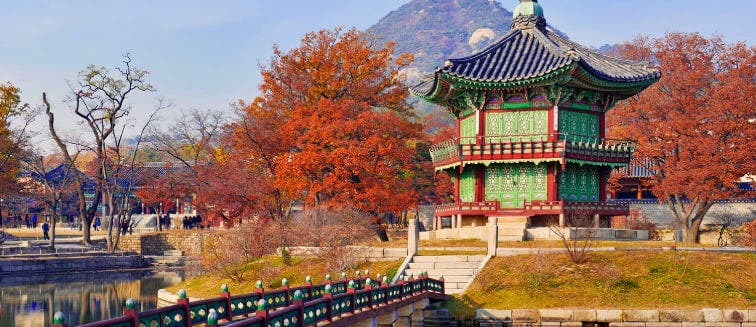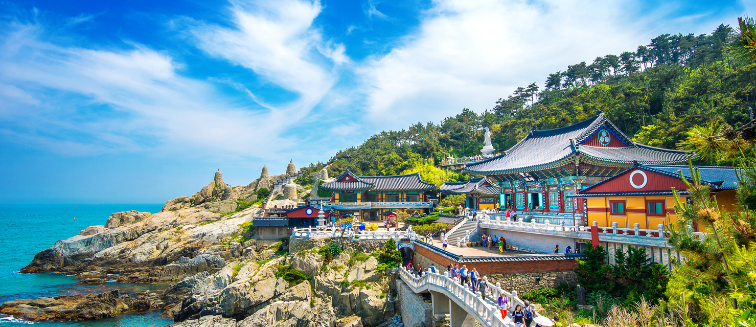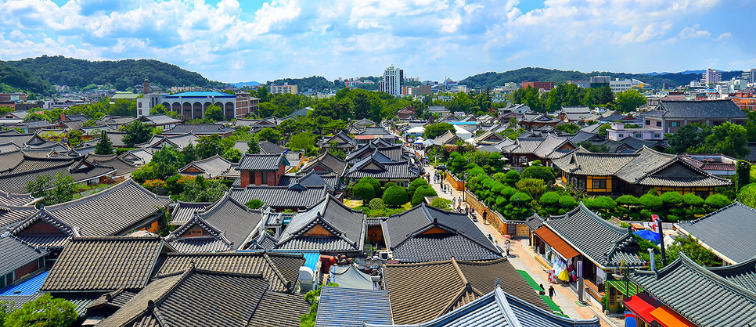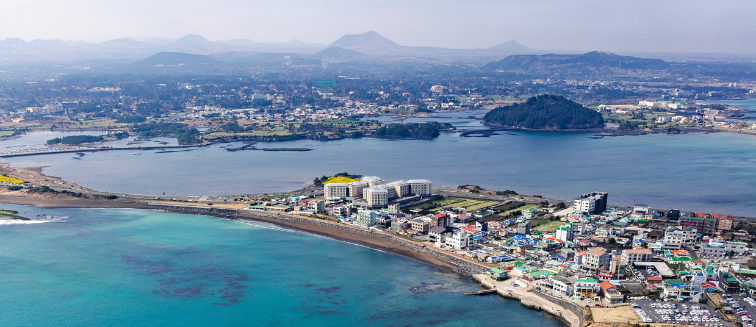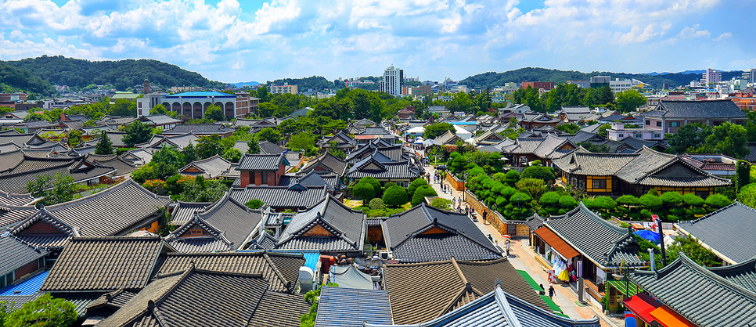Africa
Americas
Asia
Europe
Oceania
By Season
By Interest
By Group
What to see in South Korea
Seoul
Tourist attractions Seoul
Situated on the Han River, the buzzing metropolis of Seoul is the capital of South Korea and proudly the 4th largest metropolitan economy in the world, even larger than London. A trip to Seoul is sure to open your eyes to a city of contrasts, as both the ancient and ultra-modern sit side by side in this unfathomably unique capital.Founded in 18 BC by the Baekje people, one of a number of kingdoms on the Korean peninsula, Seoul became the Korean capital during the Joseon dynasty. With a backdrop of atmospheric mountains and hills, including the iconic Bukhansan mountain on the northern periphery, the city is situated close to the Yellow Sea coast in the East of the country.Seoul’s skyscrapers are perhaps its most iconic feature. The city’s modern architecture is a major attraction to visitors, with highlights such as the N Seoul Tower, standing at 263 metres in height on the Namsan mountain, impressive for its futuristic design and sheer size. The world’s 5th-tallest building, the Lotte World Tower can also be seen towering over Seoul’s skyline at 1,821 metres tall, whilst the other-worldly Dongdaemun Design Plaza in the Jung-gu neighbourhood, is renowned for its neo-futuristic design, with curved, pod-like structures in shiny materials.Inside there are a number of huge exhibition spaces, futuristic retail shops and food vendors. With such a lively arts scene it is little wonder that Seoul is the birthplace of K-Pop music and the so-called ‘Korean Wave’, a term given to the recent popularity of Korean culture worldwide. Whether you are already a fan of Korean culture or not, a holiday to Seoul is the perfect way to immerse yourself into and fall in love with the unique pop-culture so prevalent in the city.Aside from the city’s fast-paced and ultra-modern aspects, it has managed to preserve the most prized parts of its heritage and has put itself on the map for being an Asian cultural centre. With 115 museums, Seoul offers visitors a vast array of opportunities to learn about the history and culture of the city, with the largest museum, the National Museum of Korea, home to more than 200,000 artefacts that beautifully tell the narrative of the Korean peninsula.Religious monuments ranging from Confucian shrines to Catholic churches and Buddhist temples allow the visitor, on a tour of Seoul, to discover the different spiritual traditions that have helped shape the city and its history. The city’s five UNESCO World Heritage Sites are amongst its most emblematic attractions.These consist of the Changdeok Palace, one of five Joseon Dynasty grand palaces, located in Jonghogu, the Hwaseong Fortress, built in the 18th century, Namhansanseong Fortress, an extremely impressive mountain top fortress and the Tombs of the Joseon Dynasty, all of which are unmissable sights on a visit to Seoul. Finally, the Confucian Shrine of Jongmuyo stands out as the oldest preserved royal Confucian shrine.Aside from cultural attractions, ancient temples and palaces and high-tech urban structures, Seoul also boasts a lively food and drink scene with the centuries-old Gwangjong Market being the ultimate destination for trying local street food and Korean delicacies. Fill yourself up on seaweed rolls and savoury pancakes as you wander around admiring the weird and wonderful gastronomic offerings.As the 9th most visited city in the world, it is clear that a trip to Seoul is not your usual city break, but instead an unforgettable opportunity to experience the different features of Korean culture and delve into the country’s fascinating history.
Korean Demilitarized Zone
250 kilometres long and 4 kilometres wide, the Korean Demilitarized Zone is a strip of land stretching across the Korean peninsula which acts as a buffer zone between North and South Korea. Created in 1953 through an agreement between North Korea, China and the United Nations, the Demilitarized Zone or DMZ is one of the country’s top tourist attractions as it represents the turbulent history and current state of affairs between the two countries.Although the original border ran along the 38th parallel latitude line, this border became the scene of tense conflicts at the end of World War II when the Soviet Union and the USA acted as sponsor states to the North and South respectively. The Korean War followed, marking three years of conflict between 1950 and 1953, until the Armistice Agreement of 27th July 1953 established the DMZ and the moving back of troops away from the old border to the new lines of separation. Even in the present day, members of the military guard each side of the border.The area inside the DMZ is home to a number of interesting attractions. There are two villages located within the zone, who are protected by UN Command and belong to neither South or North Korea. The most iconic site is, of course, the Joint Security Area, a number of buildings designed as designated spaces for negotiations to take place between leaders of the two nations.Tours to the Korean DMZ are widely available in South Korea and are increasingly popular. A typical tour includes visits to the North Korean tunnels, a series of tunnels dug underneath the border into South Korea, for reasons not entirely clear to the outside world. Three of these tunnels are open to the public. Visitors can also enter the Joint Security Area and find themselves standing in neither South or North Korea and also take a stroll in the poignant Dorasan Peace Park, a natural area within the boundaries of the DMZ with many reminders of the Korean War, such as military tanks, scattered around the area.
OUR BEST TRIPS TO SEOUL
YOU ALSO LIKE
China
3 Trips
Hong Kong
Notify me when available
Japan
8 Trips
Mongolia
Notify me when available
South Korea
5 Trips
Taiwan
Notify me when available
Tibet
Notify me when available
Turkey
8 Trips
Jordan
9 Trips
Israel
Notify me when available
Armenia
Notify me when available
Uzbekistan
2 Trips
Oman
Notify me when available
Lebanon
Notify me when available
Kazakhstan
1 Trips
Kyrgyzstan
Notify me when available
Qatar
4 Trips
Bahrain
1 Trips
Cambodia
4 Trips
Thailand
6 Trips
Vietnam
7 Trips
Myanmar
Notify me when available
Indonesia
8 Trips
Malaysia
3 Trips
Philippines
2 Trips
Singapore
2 Trips
Laos
Notify me when available
India
13 Trips
Bhutan
2 Trips
Nepal
5 Trips
Sri Lanka
5 Trips
Maldives
6 Trips
United Arab Emirates
4 Trips
Saudi Arabia
2 Trips
Points of interests
- Trips to Andong
- Trips to Busan
- Trips to Gyeongju
- Trips to Jeju Island
- Trips to Jeonju
- Trips to Seoul
- Trips to Yeosu
Other Points of interests
- Trips to Base camp Everest
- Trips to Beijing
- Trips to Chengdu
- Trips to Chongqing
- Trips to Dunhuang
- Trips to Gion’s geisha district
- Trips to Great Wall
- Trips to Guilin
- Trips to Gyantse
- Trips to Hakone
- Trips to Hangzhou
- Trips to Hiroshima
- Trips to Hokkaido
- Trips to Hong Kong
- Trips to Huangshan
- Trips to Jiuzhaigou National Park
- Trips to Kanazawa
- Trips to Kumano Kodo
- Trips to Kyoto
- Trips to Lantau Island
- Trips to Lhasa
- Trips to Lhasa
- Trips to Li River
- Trips to Matsumoto
- Trips to Mount Fuji
- Trips to Mount Koya
- Trips to Nagoya
- Trips to Nara
- Trips to Nikko
- Trips to Okinawa
- Trips to Osaka
- Trips to Repulse Bay
- Trips to Sacred lakes
- Trips to Sapporo
- Trips to Shanghai
- Trips to Shibuya Crossing
- Trips to Shigatse
- Trips to Shirakawa-go
- Trips to Stanley Market
- Trips to Suzhou
- Trips to Taipei
- Trips to Takayama
- Trips to Three Gorges Dam
- Trips to Tokyo
- Trips to Ulaanbaatar
- Trips to Victoria Peak
- Trips to West Lake
- Trips to Wuxi
- Trips to Xi'an
- Trips to Yangshuo
- Trips to Yangtze river
- Trips to Zhangjiajie
Countries Nearby
- Armenia Trips
- Bahrain Trips
- Bhutan Trips
- Cambodia Trips
- China Trips
- Hong Kong Trips
- India Trips
- Indonesia Trips
- Israel Trips
- Japan Trips
- Jordan Trips
- Kazakhstan Trips
- Kyrgyzstan Trips
- Laos Trips
- Lebanon Trips
- Malaysia Trips
- Maldives Trips
- Mongolia Trips
- Myanmar Trips
- Nepal Trips
- Oman Trips
- Philippines Trips
- Qatar Trips
- Saudi Arabia Trips
- Singapore Trips
- South Korea Trips
- Sri Lanka Trips
- Taiwan Trips
- Thailand Trips
- Tibet Trips
- Turkey Trips
- United Arab Emirates Trips
- Uzbekistan Trips
- Vietnam Trips
Trip Styles
- Indian Subcontinent Tours for Couples Trips
- Indian Subcontinent Nature Tours Trips
- Adventure in India's Natural Beauty Trips
- Indian Ocean Nature Holidays Trips
- India Couples Tours - Exoticca Trips
- Family India Trips
- Indonesia Nature Travel Packages Trips
- Family Japan Trips
- Romantic Getaways with Exoticca Trips
- Nepal Nature Holiday Packages Trips
- Philippines Nature Tours Trips
- Family Thailand Trips
- Thailand Nature Holiday Packages Trips
- Turkey Tours for Couples Trips
- Vietnam Nature Holiday Packages Trips
Subscribe to our newsletter and join Exoticca GO
The best travel deals
Exclusive promotions
Expert travel tips
